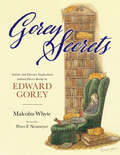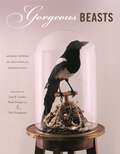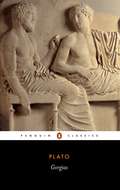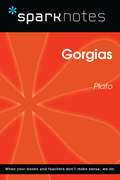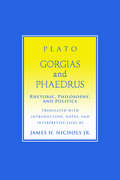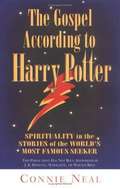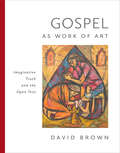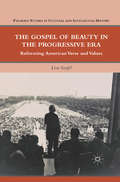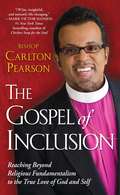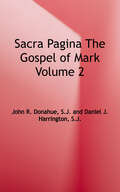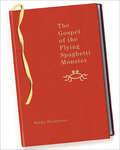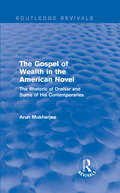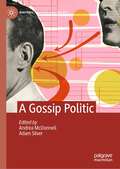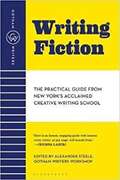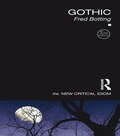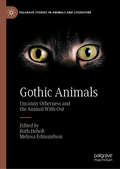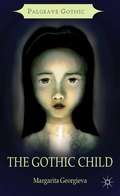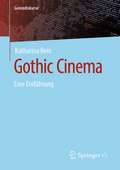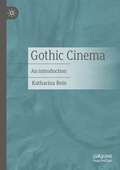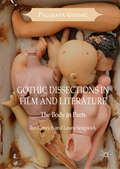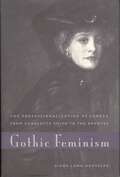- Table View
- List View
Gorey Secrets: Artistic and Literary Inspirations behind Divers Books by Edward Gorey
by Malcolm WhyteEdward Gorey (1925–2000) was a fascinating and prolific author and artist. Of the one hundred delightful and fascinating books that Gorey wrote and illustrated, he rarely revealed their specific inspirations or their meanings. Where did his intriguing ideas come from? In Gorey Secrets: Artistic and Literary Inspirations behind Divers Books by Edward Gorey, Malcolm Whyte utilizes years of thorough research to tell an engrossing, revealing story about Gorey’s unique works. Exploring a sampling of Gorey’s eclectic writings, from The Beastly Baby and The Iron Tonic to The Curious Sofa and Dracula, Whyte uncovers influences of Herman Melville, Agatha Christie, Edward Lear, the I Ching, William Hogarth, Rene Magritte, Hokusai, French cinema, early toy books, eighteenth-century religious tracts for children, and much more.With an enlightening preface by Gorey collaborator and scholar Peter F. Neumeyer, Gorey Secrets brings important, uncharted insight into the genius of Edward Gorey and is a welcome addition to collections of both the seasoned Gorey reader and those who are just discovering his captivating books.
Gorgeous Beasts: Animal Bodies in Historical Perspective (Animalibus)
by Joan B. Landes Paula Young Lee Paul YoungquistGorgeous Beasts takes a fresh look at the place of animals in history and art. Refusing the traditional subordination of animals to humans, the essays gathered here examine a rich variety of ways animals contribute to culture: as living things, as scientific specimens, as food, weapons, tropes, and occasions for thought and creativity. History and culture set the terms for this inquiry. As history changes, so do the ways animals participate in culture. Gorgeous Beasts offers a series of discontinuous but probing studies of the forms their participation takes. This collection presents the work of a wide range of scholars, critics, and thinkers from diverse disciplines: philosophy, literature, history, geography, economics, art history, cultural studies, and the visual arts. By approaching animals from such different perspectives, these essays broaden the scope of animal studies to include specialists and nonspecialists alike, inviting readers from all backgrounds to consider the place of animals in history and art. Combining provocative critical insights with arresting visual imagery, Gorgeous Beasts advances a challenging new appreciation of animals as co-inhabitants and co-creators of culture.Aside from the editors, the contributors are Dean Bavington, Ron Broglio, Mark Dion, Erica Fudge, Cecilia Novero, Harriet Ritvo, Nigel Rothfels, Sajay Samuel, and Pierre Serna.
Gorgeous Beasts: Animal Bodies in Historical Perspective (Animalibus: Of Animals and Cultures #2)
by Paula Young Lee Joan B. Landes Paul YoungquistGorgeous Beasts takes a fresh look at the place of animals in history and art. Refusing the traditional subordination of animals to humans, the essays gathered here examine a rich variety of ways animals contribute to culture: as living things, as scientific specimens, as food, weapons, tropes, and occasions for thought and creativity. History and culture set the terms for this inquiry. As history changes, so do the ways animals participate in culture. Gorgeous Beasts offers a series of discontinuous but probing studies of the forms their participation takes. This collection presents the work of a wide range of scholars, critics, and thinkers from diverse disciplines: philosophy, literature, history, geography, economics, art history, cultural studies, and the visual arts. By approaching animals from such different perspectives, these essays broaden the scope of animal studies to include specialists and nonspecialists alike, inviting readers from all backgrounds to consider the place of animals in history and art. Combining provocative critical insights with arresting visual imagery, Gorgeous Beasts advances a challenging new appreciation of animals as co-inhabitants and co-creators of culture.Aside from the editors, the contributors are Dean Bavington, Ron Broglio, Mark Dion, Erica Fudge, Cecilia Novero, Harriet Ritvo, Nigel Rothfels, Sajay Samuel, and Pierre Serna.
Gorgias
by PlatoTaking the form of a dialogue between Socrates, Gorgias, Polus and Callicles, GORGIAS debates perennial questions about the nature of government and those who aspire to public office. Are high moral standards essential or should we give our preference to the pragmatist who gets things done or negotiates successfully? Should individuals be motivated by a desire for personal power and prestige, or genuine concern for the moral betterment of the citizens? These questions go to the heart of Athenian democratic principles and are more relevant than ever in today's political climate.
Gorgias (SparkNotes Philosophy Guide)
by SparkNotesGorgias (SparkNotes Philosophy Guide) Making the reading experience fun! SparkNotes Philosophy Guides are one-stop guides to the great works of philosophy–masterpieces that stand at the foundations of Western thought. Inside each Philosophy Guide you&’ll find insightful overviews of great philosophical works of the Western world.
"Gorgias" and "Phaedrus": Rhetoric, Philosophy, and Politics
by Plato James H. Nichols Jr.With a masterful sense of the place of rhetoric in both thought and practice and an ear attuned to the clarity, natural simplicity, and charm of Plato's Greek prose, James H. Nichols Jr., offers precise yet unusually readable translations of two great Platonic dialogues on rhetoric.The Gorgias presents an intransigent argument that justice is superior to injustice: To the extent that suffering an injustice is preferable to committing an unjust act. The dialogue contains some of Plato's most significant and famous discussions of major political themes, and focuses dramatically and with unrivaled intensity on Socrates as a political thinker and actor. Featuring some of Plato's most soaringly lyrical passages, the Phaedrus investigates the soul's erotic longing and its relationship to the whole cosmos, as well as inquiring into the nature of rhetoric and the problem of writing.Nichols's attention to dramatic detail brings the dialogues to life. Plato's striking variety in conversational address (names and various terms of relative warmth and coolness) is carefully reproduced, as is alteration in tone and implication even in the short responses. The translations render references to the gods accurately and non-monotheistically for the first time, and include a fascinating variety of oaths and invocations. A general introduction on rhetoric from the Greeks to the present shows the problematic relation of rhetoric to philosophy and politics, states the themes that unite the two dialogues, and outlines interpretive suggestions that are then developed more fully for each dialogue.The twin dialogues reveal both the private and the political rhetoric emphatic in Plato's philosophy, yet often ignored in commentaries on it. Nichols believes that Plato's thought on rhetoric has been largely misunderstood, and he uses his translations as an opportunity to reconstruct the classical position on right relations between thought and public activity.
The Gospel According to Harry Potter: Spirituality in the Stories of the World's Most Famous Seeker
by Connie Nealfrom a Review of "The Gospel According to Harry Potter by Connie Neal" by Jonathan Marlowe, pastor of Shiloh United Methodist Church in Granit Quarry, NC Connie Neal goes carefully through the four Harry Potter books that have been published so far, and patiently shows us the same kind of "points of contact" with the Bible that I discussed with the children in my church. These "points of contact" (or "glimmers of the gospel," as she calls them) include how Lily Potter's sacrifice for the sake of her son Harry corresponds to Christ's sacrifice for us on the cross, how Dumbledore's deep wisdom mirrors the character of God, and how evil forces operate through deception and violence. Neal is careful not to treat the Potter series as Christian allegory, acknowledging that the Potter stories are different from C.S. Lewis' Chronicles of Narnia. But she wants to prove that J. K. Rowling was right when she said, "You can find in these stories whatever you are looking for." So many have found evidence of witchcraft and the occult in these stories because that is what they were seeking. But Neal has gone to the same stories looking instead for the gospel, and much to the reader's delight, she has found it.
Gospel as Work of Art: Imaginative Truth and the Open Text
by David BrownA lushly illustrated, magisterial exploration of the imaginative truth of the gospel In the modern academy, truth and imagination are thought to be mutually exclusive. But what if truth can spring from other fonts, like art, literature, and invention? The legacy of the Enlightenment favors historical and empirical inquiry above all other methods for searching for truth. But this assumption stymies our theological explorations. Though the historicity of Jesus&’s life, death, and resurrection is important, it is not of sole importance. For instance, is John&’s Gospel any less &“true&” than the Synoptics just because it&’s less historically accurate? David Brown challenges us to expand our understanding of the gospel past source criticism and historical Jesus studies to include works of imagination. Reading Scripture in tandem with works of art throughout the centuries, Brown reenvisions the gospel as an open text. Scholars of theology and biblical studies, freed from literalism, will find new avenues of revelation in Gospel as Work of Art. This volume includes over one hundred color illustrations.
The Gospel of Beauty in the Progressive Era
by Lisa SzefelSzefel investigates the use of poetry in addressing political reform at the turn of the twentieth century. It charts the work of poets and editors - many of whom were women and minorities - who created a network of organizations to nurture writers who addressed the problems wrought by Progressive-era capitalism.
The Gospel of Inclusion: Reaching Beyond Religious Fundamentalism to the True Love of God and Self
by Carlton PearsonFourth-generation fundamentalist Carlton Pearson, a Christian megastar and host, takes a courageous and controversial stand on religion that proposes a hell-less Christianity and a gospel of inclusion that calls for an end to local and worldwide conflicts and divisions along religious lines.In The Gospel of Inclusion, Bishop Carlton Pearson explores the exclusionary doctrines in mainstream religion and concludes that, according to the evidence of the Bible and irrefutable logic, they cannot be true. Bishop Pearson argues that the controlling dogmas of religion are the source of much of the world's ills and that we should turn our backs on proselytizing and holy wars and focus on the real good news: that we are all bound for glory, everybody is saved, and if we believe God loves all mankind, then we have no choice but to have the same attitude ourselves. Bishop Pearson tells the story of how he had gone from a powerful religious figure, once preaching to an audience of over 6,000 people, to watching everything he had built crumble around him due to a scandal. Why? He didn't steal money nor did he have inappropriate sexual relationships. Following a revelation from God, he began to preach that a loving God would not condemn most of the human race to hell because they are not Christian. He preaches that God belongs to no religion. The Gospel of Inclusion is the inspiring journey of one man's quest to preach a new truth.
The Gospel of Mark (Sacra Pagina Series #2)
by John R. Donahue Daniel J. HarringtonIn The Gospel of Mark, Fathers Donahue and Harrington use an approach that can be expressed by two terms currently used in literary criticism: intratextuality and intertextuality. This intratextual and intertextual reading of Mark''s Gospel helps us to appreciate the literary character, its setting in life, and its distinctive approaches to the Old Testament, Jesus, and early Christian theology. <p><p>"Intratextuality" means we read Mark as Mark and by Mark. Such a reading expresses interest in the final form of the Gospel (not its source or literary history) and in its words and images, literary devices, literary forms, structures, characterization, and plot. Reading Mark by Mark gives particular attention to the distinctive vocabulary and themes that run throughout the Gospel and serve to hold it together as a unified literary production. <p><p>"Intertextuality" comprises the relation between texts and a textual tradition, and also referring to contextual materials not usually classified as texts (e.g., archaeological data). "Intertextuality" is used to note the links of the text of Mark''s Gospel to other texts (especially the Old Testament) and to the life of the Markan community and of the Christian community today.
The Gospel of the Flying Spaghetti Monster
by Bobby HendersonCAN I GET A “RAMEN” FROM THE CONGREGATION?!Behold the Church of the Flying Spaghetti Monster (FSM), today’s fastest growing carbohydrate-based religion. According to church founder Bobby Henderson, the universe and all life within it were created by a mystical and divine being: the Flying Spaghetti Monster. What drives the FSM’s devout followers, a.k.a. Pastafarians? Some say it’s the assuring touch from the FSM’s “noodly appendage.” Then there are those who love the worship service, which is conducted in pirate talk and attended by congregants in dashing buccaneer garb. Still others are drawn to the Church’s flimsy moral standards, religious holidays every Friday, or the fact that Pastafarian heaven is way cooler: Does your heaven have a Stripper Factory and a Beer Volcano? Intelligent Design has finally met its match–and it has nothing to do with apes or the Olive Garden of Eden.Within these pages, Bobby Henderson outlines the true facts– dispelling such malicious myths as evolution (“only a theory”), science (“only a lot of theories”), and whether we’re really descended from apes (fact: Humans share 95 percent of their DNA with chimpanzees, but they share 99.9 percent with pirates!)See what impressively credentialed top scientists have to say:“If Intelligent Design is taught in schools, equal time should be given to the FSM theory and the non-FSM theory.”–Professor Douglas Shaw, Ph.D. “Do not be hypocritical. Allow equal time for other alternative ‘theories’ like FSMism, which is by far the tastier choice.”–J. Simon, Ph.D.“In my scientific opinion, when comparing the two theories, FSM theory seems to be more valid than classic ID theory.”–Afshin Beheshti, Ph.D.Read the book and decide for yourself!From the Trade Paperback edition.
The Gospel of Wealth in the American Novel: The Rhetoric of Dreiser and Some of His Contemporaries (Routledge Revivals)
by Arun MukherjeeBusiness and the businessman have had a fundamental place in American society since the inception of the nation. This tenet, the ‘gospel of wealth’, is a central concern in the novels of Theodore Dreiser and his contemporaries. First published in 1987, this study sets this group of writers in their historical context and shows how they elaborated the idea of wealth as an object of quasi-religious quest. What had previously been associated with disease and darkness, avarice and dishonour, now came to emblematise the virtues of thrift, prudence and diligence. The underlying argument is that the dominant group of a society legitimises its power through the appropriation of the vocabulary of religion, and the American business leaders were successful in doing this both in their own practice and through the more insidious medium of art. A detailed analysis, this reissue will be of particular value to students of American literature with an interest in the relationship between linguistic symbols and social order, and historical attitudes towards wealth in literature.
A Gossip Politic (Rhetoric, Politics and Society)
by Andrea McDonnell Adam SilverThis book makes explicit the historical, technological, and discursive links between gossip as a mode of communication, news media, and contemporary politics. A Gossip Politic advances a new framework of gossip, applying the informal understanding of the term to news talk and political actors. Authored by esteemed scholars in the fields of Political Science, Media Studies, Linguistics, and Sociology, chapters consider the influence of gossip on the press, the American presidency, and the public. A Gossip Politic provides readers with a multi-faceted portrait of the ways in which gossip has influenced media history, shaped our understanding of democracy, and contributed to our current political landscape.
Gotham Writers' Workshop: The Practical Guide From New York's Acclaimed Creative Writing School
by Gotham Writers' Workshop Nikki MoustakiHere you'll find: The fundamental elements of fiction craft―character, plot, point of view, etc.―explained clearly and completely - Key concepts illustrated with passages from great works of fiction - The complete text of "Cathedral" by Raymond Carver―a masterpiece of contemporary short fiction that is analyzed throughout the book - Exercises that let you immediately apply what you learn to your own writing. Written by Gotham Writers' Workshop expert instructors and edited by Dean of Faculty Alexander Steele, Writing Fiction offers the same methods and exercises that have earned the school international acclaim. Once you've read―and written―your way through this book, you'll have a command of craft that will enable you to turn your ideas into effective short stories and novels. You will be a writer. Gotham Writers' Workshop is America's leading private creative writing school, offering classes in New York City and on the web at WritingClasses.com. The school's interactive online classes, selected "Best of the Web" by Forbes, have attracted thousands of aspiring writers from across the United States and more than sixty countries.
Gothic: Critical Concepts In Literary And Cultural Studies (The New Critical Idiom)
by Fred BottingThis enduringly popular book has become a classic in the expanding and increasingly popular field of Gothic Studies. This long awaited new edition contains a new chapter on ‘Contemporary Gothic’, an expanded section on American Gothic and more discussion of the gothic in women’s film and writing throughout the book. It is also updated in relation to media and technology with further discussion of stage sensations and photography as well as engaging with all major texts and criticism since initial publication in 1995. With the added benefit of series features such as a glossary and annotated further reading section, this remains the ideal guide to the Gothic.
Gothic Animals: Uncanny Otherness and the Animal With-Out (Palgrave Studies in Animals and Literature)
by Melissa Edmundson Ruth HeholtThis book begins with the assumption that the presence of non-human creatures causes an always-already uncanny rift in human assumptions about reality. Exploring the dark side of animal nature and the ‘otherness’ of animals as viewed by humans, and employing cutting-edge theory on non-human animals, eco-criticism, literary and cultural theory, this book takes the Gothic genre into new territory. After the dissemination of Darwin’s theories of evolution, nineteenth-century fiction quickly picked up on the idea of the ‘animal within’. Here, the fear explored was of an unruly, defiant, degenerate and entirely amoral animality lying (mostly) dormant within all of us. However, non-humans and humans have other sorts of encounters, too, and even before Darwin, humans have often had an uneasy relationship with animals, which, as Donna Haraway puts it, have a way of ‘looking back’ at us. In this book, the focus is not on the ‘animal within’ but rather on the animal ‘with-out’: other and entirely incomprehensible.
The Gothic Body
by Kelly HurleyReaders familiar with Dracula and The Strange Case of Dr Jekyll and Mr Hyde may not know that dozens of equally remarkable Gothic texts were written in Great Britain at the end of the nineteenth-century. This book accounts for the resurgence of Gothic, and its immense popularity, during the British fin de siecle. Kelly Hurley explores a key scenario that haunts the genre: the loss of a unified and stable human identity, and the emergence of a chaotic and transformative 'abhuman' identity in its place. She shows that such representations of Gothic bodies are strongly indebted to those found in nineteenth-century biology and social medicine, evolutionism, criminal anthropology, and degeneration theory. Gothic is revealed as a highly productive and speculative genre, standing in opportunistic relation to nineteenth-century scientific and social theories.
The Gothic Child
by Margarita GeorgievaFascination with the dark and death threats are now accepted features of contemporary fantasy and fantastic fictions for young readers. These go back to the early gothic genre in which child characters were extensively used by authors. The aim of this book is to rediscover the children in their work.
Gothic Cinema: Eine Einführung (Genrediskurse)
by Katharina ReinMit Gothic Cinema schließt sich eine Lücke im deutschsprachigen Filmdiskurs: Erstmalig beleuchtet der Band einen bislang wenig diskutierten Filmzusammenhang. Er betrachtet das Gothic Cinema als als eine Form inoffizieller Historiographie, die einen Blick nicht nur auf die Geschichte des Films und seiner Technik, sondern auch auf Moralvorstellungen, Geschlechterverhältnisse, kollektive Ängste oder ästhetische Strömungen zulässt. Auf eine Abgrenzung und Bestimmung des Begriffs und der zentralen Elemente des Gothic folgt ein umfassender historischer Überblick von 1896 bis zur heutigen Zeit. Drei ausführliche Analysen einzelner Gothic-Filme und Fernsehserien nach 2015 runden die Betrachtung ab. Die untersuchten Beispiele sind einerseits repräsentativ im Hinblick auf typische Elemente, Motive oder Topoi und weisen andererseits Besonderheiten und Brüche auf, die sich für eine kultur- und medienwissenschaftliche Untersuchung als fruchtbar erweisen.
Gothic Cinema: An introduction
by Katharina ReinGothic Cinema closes a gap in German-language film discourse: for the first time, the volume sheds light on a hitherto little-discussed film context. It considers Gothic Cinema as a form of unofficial historiography that allows a look not only at the history of film and its technique, but also at moral concepts, gender relations, collective fears or aesthetic currents. A delimitation and definition of the term and the central elements of the Gothic are followed by a comprehensive historical overview from 1896 to the present day. Three in-depth analyses of individual post-2015 gothic films and television series round out the review. On the one hand, the examples examined are representative in terms of typical elements, motifs or topoi, and on the other hand, they exhibit peculiarities and breaks that prove fruitful for a cultural and media studies investigation.
Gothic Dissections in Film and Literature
by Ian Conrich Laura SedgwickThis is the first book-length study to systematically and theoretically analyse the use and representation of individual body parts in Gothic fiction. Moving between filmic and literary texts and across the body--from the brain, hair and teeth, to hands, skin and the stomach--this book engages in unique readings by foregrounding a diversity of global representations. Building on scholarly work on the 'Gothic body' and 'body horror', Gothic Dissections in Film and Literature dissects the individual features that comprise the physical human corporeal form in its different functions. This very original and accessible study, which will appeal to a broad range of readers interested in the Gothic, centralises the use (and abuse) of limbs, organs, bones and appendages. It presents a set of unique global examinations; from Brazil, France and South Korea to name a few; that address the materiality of the Gothic body in depth in texts ranging from the nineteenth century to the present; from Nikolai Gogol, Edgar Allan Poe, Roald Dahl and Chuck Palahniuk, to David Cronenberg, Freddy Krueger and The Greasy Strangler.
The Gothic Family Romance: Heterosexuality, Child Sacrifice, and the Anglo-Irish Colonial Order
by Margot BackusTales of child sacrifice, demon lovers, incestual relations, and returns from the dead are part of English and Irish gothic literature. Such recurring tropes are examined in this pioneering study by Margot Gayle Backus to show how Anglo-Irish gothic works written from the eighteenth through the twentieth centuries reflect the destructive effects of imperialism on the children and later descendents of Protestant English settlers in Ireland. Backus uses contemporary theory, including that of Michel Foucault and Eve Kosofsky Sedgwick, to analyze texts by authors ranging from Richardson, Swift, Burke, Edgeworth, Stoker, and Wilde to contemporary Irish novelists and playwrights.By charting the changing relations between the family and the British state, she shows how these authors dramatized a legacy of violence within the family cell and discusses how disturbing themes of child sacrifice and colonial repression are portrayed through irony, satire, "paranoid" fantasy, and gothic romance. In a reconceptualization of the Freudian family romance, Backus argues that the figures of the Anglo-Irish gothic embody the particular residue of childhood experiences within a settler colonial society in which biological reproduction represented an economic and political imperative. Backus's bold positioning of the nuclear family at the center of post-Enlightenment class and colonial power relations in England and Ireland will challenge and provoke scholars in the fields of Irish literature and British and postcolonial studies. The book will also interest students and scholars of women's studies, and it has important implications for understanding contemporary conflicts in Ireland.
Gothic Feminism: The Professionalization of Gender from Charlotte Smith to the Brontës (G - Reference, Information and Interdisciplinary Subjects)
by Diane Long HoevelerAs British women writers in the late eighteenth and early nineteenth centuries sought to define how they experienced their era's social and economic upheaval, they helped popularize a new style of bourgeois female sensibility. Building on her earlier work in Romantic Androgyny, Diane Long Hoeveler now examines the Gothic novels of Charlotte Smith, Ann Radcliffe, Jane Austen, Charlotte Dacre Byrne, Mary Shelley, and the Brontës to show how these writers helped define femininity for women of the British middle class.Hoeveler argues that a female-created literary ideology, now known as "victim feminism," arose as the Gothic novel helped create a new social role of professional victim for women adjusting to the new bourgeois order. These novels were thinly disguised efforts at propagandizing a new form of conduct for women, teaching that "professional femininity"—a cultivated pose of wise passiveness and controlled emotions—best prepared them for social survival. She examines how representations of both men and women in these novels moved from the purely psychosexual into social and political representations, and how these writers constructed a series of ideologies that would allow their female characters—and readers—fictitious mastery over an oppressive social and political system.Gothic Feminism takes a neo-feminist approach to these women's writings, treating them not as sacred texts but as thesis-driven works that attempted to instruct women in a series of strategic poses. It offers both a new understanding of the genre and a wholly new interpretation of feminism as a literary ideology.
Gothic for Girls: Misty and British Comics
by Julia RoundWinner of the 2019 Broken Frontier Award for Best Book on ComicsToday fans still remember and love the British girls’ comic Misty for its bold visuals and narrative complexities. Yet its unique history has drawn little critical attention. Bridging this scholarly gap, Julia Round presents a comprehensive cultural history and detailed discussion of the comic, preserving both the inception and development of this important publication as well as its stories. Misty ran for 101 issues as a stand-alone publication between 1978 and 1980 and then four more years as part of Tammy. It was a hugely successful anthology comic containing one-shot and serialized stories of supernatural horror and fantasy aimed at girls and young women and featuring work by writers and artists who dominated British comics such as Pat Mills, Malcolm Shaw, and John Armstrong, as well as celebrated European artists. To this day, Misty remains notable for its daring and sophisticated stories, strong female characters, innovative page layouts, and big visuals.In the first book on this topic, Round closely analyzes Misty’s content, including its creation and production, its cultural and historical context, key influences, and the comic itself. Largely based on Round’s own archival research, the study also draws on interviews with many of the key creators involved in this comic, including Pat Mills, Wilf Prigmore, and its art editorial team Jack Cunningham and Ted Andrews, who have never previously spoken about their work. Richly illustrated with previously unpublished photos, scripts, and letters, this book uses Misty as a lens to explore the use of Gothic themes and symbols in girls’ comics and other media. It surveys existing work on childhood and Gothic and offers a working definition of Gothic for Girls, a subgenre which challenges and instructs readers in a number of ways.
